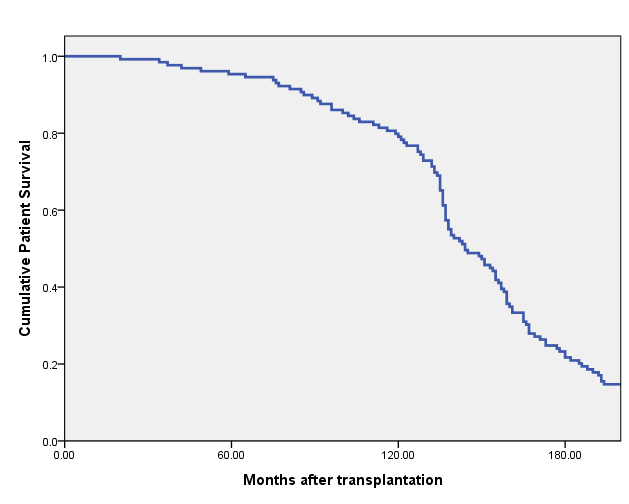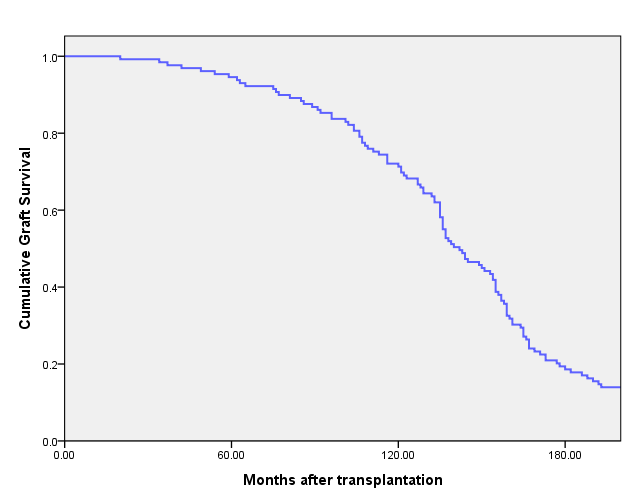Long-Term Survival Analysis of Kidney Transplant Recipients Receiving Mizoribine as a Maintenance Immunosuppressant
1Nephrology, Bongseng hospital, Busan, Korea, Republic of, 2Nephrology, Donga University hospital, Busan, Korea, Republic of
Meeting: 2019 American Transplant Congress
Abstract number: A268
Keywords: Immunosuppression, Kidney transplantation
Session Information
Session Name: Poster Session A: Kidney Immunosuppression: Novel Regimens and Drug Minimization
Session Type: Poster Session
Date: Saturday, June 1, 2019
Session Time: 5:30pm-7:30pm
 Presentation Time: 5:30pm-7:30pm
Presentation Time: 5:30pm-7:30pm
Location: Hall C & D
*Purpose: It has proved effective as a treatment for lupus nephritis, rheumatoid arthritis, and nephrotic syndrome, after mizoribine was introduced as an immunosuppressive agent to prevent rejection after renal transplantation. However, most studies on mizoribine have been performed in Japan, and there is a lack of reports on long-term use in other countries. The purpose of this study is to examine the efficacy and safety of mizoribine in Korean patients with who received renal transplants by observing the clinical course of renal transplant recipients and analyzing long-term patients and graft survival rates.
*Methods: We studied 129 subjects who have received mizoribine as a maintenance immunosuppressant after renal transplantation since January 2000. We performed the survival analysis based by their medical records from January 2000 to December 2017.
*Results: The overall survival rate of renal transplant recipients was 99.2% at 1 year, 95.3% at 5 years, 79.1% at 10 years, 23.3% at 15 years and graft survival rate was 99.2% at 1 year, 94.6% at 5 years, 71.3% at 10 years and 18.6% at 15 years. There was only one difference in recipient survival and graft survival rate between the living donor renal transplantation and deceased donor transplant. There was no difference in the survival rates according to the presence of rejection, the dose of mizoribine, the type of underlying disease, and other clinical factors.
*Conclusions: The use of standard doses of mizoribine as a maintenance immunosuppressant could be a way to ensure a good long-term graft survival of renal transplant relatively
| Mean dose | 2.2 |
| Minimum | 0.9 |
| Maximum | 3.9 |
| 25 percentiles | 1.8 |
| 50 percentiles | 2.3 |
| 75 percentiles | 2.7 |
| Malignancy | 5 (3.9%) |
| Infection | 20 (16%) |
| Acute cellular rejection | 15 (11.6%) |
| Antibody mediated rejection | 3 (2.3%) |
| IFTA | 8 (6.2%) |
| Recurred GN | 5 (3.9%) |
| BKVAN | 1 (0.8%) |
To cite this abstract in AMA style:
Kim J, Lee D, Oh J, Lee J, Kim H, Son Y. Long-Term Survival Analysis of Kidney Transplant Recipients Receiving Mizoribine as a Maintenance Immunosuppressant [abstract]. Am J Transplant. 2019; 19 (suppl 3). https://atcmeetingabstracts.com/abstract/long-term-survival-analysis-of-kidney-transplant-recipients-receiving-mizoribine-as-a-maintenance-immunosuppressant/. Accessed December 7, 2025.« Back to 2019 American Transplant Congress


